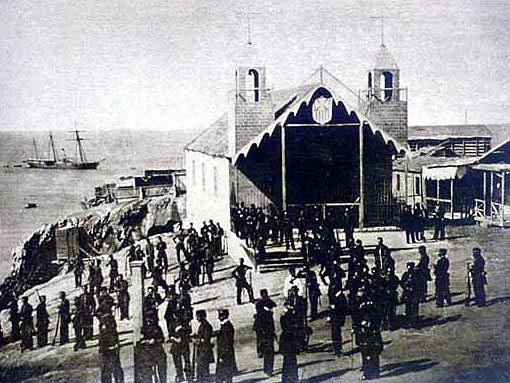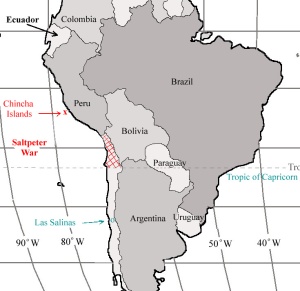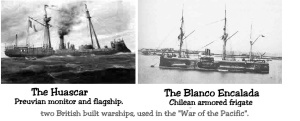The Nitrate Wars
Ancient Chinese alchemist apparently overturned much dried livestock dung to collect the tiny white potassium nitrate crystals underneath. Mixed with sulfur and charcoal this becomes the gunpowder that has helped reshape the world’s political map for the last 5 or 6 centuries. Wide demand for nitrates led to the discovery of one of the world’s few sources of nitrate rich deposits in the 1840’s; first offshore and then inland within the Atacama Desert (one of the world’s driest). Control over these lucrative and strategically critical deposits led to two relatively unknown wars in which Europeans either directly or indirectly participated.
Footnotes beforehand:
-Nitric acid has the chemical formula (HNO3) and can be made by several different processes. Worry not, I’ll omit those details, here.
-Nitric acid is an essential building block for a major number of common explosives, many of which were invented just before the nitrate wars in South America. Some examples follow.
-Mercury fulminate – first created in 1800, was used as a priming compound for ammunition since the 1830’s and in detonators since the 1860’s.
– Nitrostarch (1833) was probably the first true “high explosive”.
– Nitrocellulose (guncotton or collodion) was sort of co-invented by three separate and independent chemists around 1846. One of those chemists mopped up a small spill of nitric acid with his apron and hung it on the door of a heating stove to dry. Some details are missing as was the stove some short time later.
– Nitroglycerin (1847) was invented by an Italian who attended the same chemistry class as Alfred Nobel at Turin University, Italy
– Dynamite (1867), Gelignite (1879) and Ballistite (1887) were invented and patented by Alfred Nobel – a business move that made Alfred wealthy. Dynamite is nitroglycerin absorbed in diatomite (diatomaceous clay) and rolled in paper. Nitroglycerin desensitized this way, when combined with a pyrotechnic blasting cap (also invented by Nobel) made a safe explosive combination for mining, excavation and construction. Dynamite did not make a very practical munition for war.
– TNP (trinitriphenol or picric acid) was invented somewhere back in the 1770’s but was not used as an explosive until the 1830’s.
– TNT (trinitrotoluene or triple-nitrated-toluene) was invented in 1863 but was so insensitive that it took another 40 years before it saw use in munitions.
– Several of these compounds are still used as building blocks for modern explosives.
The Dung War
Actually the “Guano War” is more properly referred to as the “Chincha Islands War” and occurred between 1864 and 1866 (somewhat concurrent with the American Civil War). Mining for nitrate rich guano deposits in the form of mountains of partially fossilized bird excrement had been conducted on the islands since 1840. The short war is summarized by a modern but ineffective Spanish naval squadron under Isabella II’s bequest, running up and down the Pacific South American coast line while trying to reinstate Spanish influence in the area. The Spanish occupied the Chincha islands and bombarded targets along the coast from Peru to Valparaiso, Chile. Peru and Chile formed a short lived alliance to resist the Spanish. Both sides had ironclad ships. The Spanish flagship was the powerful armored frigate Numancia which was bought from France. The Chileans did not have much of a navy at the time and lost most of their merchant ships but the Peruvians had four ironclads. Two of the Peruvian ironclads Huáscar and Independencia had recently been purchased from Brittan while the other two were homemade. Just two years after the shootout between the Monitor and Merrimack at Hampton Roads in North America, the Peruvians constructed their own small monitor (Victoria) and the ironclad Loa (which resembled the CSS Virginia or Merrimack). The Chilean army had modern European cannons and rifles. Without land forces or the power to do anything decisive, the Spanish eventually left, returning to Spain by way of the Philippines and circumnavigating the globe in the process.
– Bird guano, the feces and urine of seabirds in this case, can contain as much as 16% nitrogen (mostly from uric acid), 12% phosphoric acid and 3% potash. Bat guano was highly valuable too but apparently a little weaker in nitrogen content. Apparently seal guano was sought after also but to a lesser degree.
The Saltpeter War
– Saltpeter can refer to several different compounds. Sodium nitrate is usually a mineral that is mined, and is called ‘Peru saltpeter’ or ‘Chile saltpeter’. Potassium nitrate or ‘niter’ was a traditional component of gunpowder and was originally obtained from guano. Both Sodium and Potassium nitrates are used today as food preservatives, fertilizers and as oxidizers for explosives and propellants. Snopes declares that potassium nitrate is not an anaphrodisiac (the opposite of an aphrodisiac) but Wikipedia appears noncommittal on the subject. Calcium nitrate (mostly from Norway) and Magnesium nitrate are also called saltpeter. Ammonium nitrate will be discussed in a minute.
Following the Chincha Islands War the bird guano became exhausted by about 1870 but rich new sodium nitrate deposits were soon discovered in the Atacama Desert. European mining engineers and technology quickly poured into the region. With profits soaring from “boom-town” saltpeter mining, Chile and Peru bought the best European and American arms they could find. Both countries acquired the latest in 19th century military technology available from the outside world; including breach loading rifles, artillery and remote controlled landmines. These countries bought modern torpedo boats, broadside firing ironclads and revolving turreted monitors from Brittan, France and the U.S. Peru for example bought the USS Catawba and Oneota ex-Civil War monitors while Chile bought gunboats like the USS Cherokee and modern French corvettes.
Bolivia had a sea shore at one time but unfortunately the best sodium nitrate deposits lay under territory that it claimed. After Peru and Bolivia tried to nationalize and tax the infrastructure that Chile had had a large hand in exploiting, war broke out in 1879. Before the war Chile’s northern border had been on the 24th parallel, just 60km south of the Tropic of Capricorn (±23.45 degrees today but changing). The five year long Saltpeter war or ‘War of the Pacific’ eventually saw Chile win against and ravish the Peruvian-Bolivian alliance. Unlike the previous Guano War, the Saltpeter War witnessed several brutal land engagements in both mountainous and flat desert terrain. Unlike the Bolivian and Peruvian armies, the Chilean army was organized and well equipped. The first year of the war was mostly a naval campaign. Bolivia withdrew from the conflict in the second year (1880). After having established sea dominance Chile was able to support and resupply its far flung desert troops whereas Peru was not.

<before the war – public domain image>
There is still a great animosity over this incident today. The real profiteer in the whole affair was Great Britain, who had largely financed the production of this extremely strategic mineral. Britain, the world’s strongest sea-power at the time acquired the ‘lion’s share’ of saltpeter production after the war, and later was able to blockade its importation to Germany throughout both World Wars. Not that that mattered very much because by 1909 a German chemist named Fritz Haber discovered a way to pull nitrogen from the very air and combine it with hydrogen to produce ammonia. On an industrial scale, ammonia can be oxidized to make nitric acid and therefore many propellants and explosives. Although some ammonia nitrate can be found in nature the vast majority of this important fertilizer and blasting agent is made by reacting nitric acid with the base ammonia (both made by the Haber process).
————————————
*More than 100 islands possessing prominent quantities of bird droppings were claimed for the U.S. following the Guano Island Act of 1856. Today about a dozen islands (including Midway and Johnston atolls) that were acquired this way are still considered as United States territory.
————————————
More Trivia
– Interestingly the Peruvians actually constructed their own submarine during the Saltpeter War (with the help of a German engineer). Made about 15 years after the conclusion of the American Civil War, the “Toro” (Spanish for ‘Bull’) resembled the early American submarines USS Alligator and CSS Hunley and was also propelled by hand-cranked propeller. Most people don’t know that the U.S. Navy had its own submarine a year before the more famous CSS Hunley was launched. The Alligator and Toro saw no action though while the Hunley actually sank the USS Housatonic. Contemporary and famous author Clive Cussler was instrumental in the rediscovery of the CSS Hunley, a century after that action.

– Submarine like torpedo boats such as the semi-submersible CSS (Confederate States Ship) David might have proved to be much more damaging than they did. With little more than the navigators head and a small smoke stack sticking out of the water, these steam powered boats would have been very hard to see when burning anthracite coal under low light conditions. The David and the Hunley used a bomb stuck on the end of a pole, called a ‘spar torpedo’. Other bombs that attach to the enemy ship’s hull are now called ‘limpet mines’ but back then everything was called a torpedo.
– The glorious Clipper ships reigned supreme on the oceans between the 1840’s and the opening of the Suez canal. The Clippers lost their lucrative passenger, tea and opium cargoes to ships with a combination of sail and steam. Many surviving clippers were reduced to hauling coal, metal ores, guano and mineral nitrates. The Preussen was a fast sailing ship designed specifically to haul bulk freight like Chilean saltpeter.
– Another bit of trivia not associated with the wars: apparently the first solar stills ever made were constructed in the Chilean nitrate mining community of Las Salinas in 1872. A Swedish engineer named Charles Wilson apparently constructed a series of stills that were eventually capable of purifying 23,000 liters of clean water from brackish water, per day.
– Currently (Oct 2018) the two companies: Albemarle Corp and SQM are squabbling over water rights in the Atacama’s remote Salar basin. This basin has some of the world’s richest deposits of high-grade lithium, and water is needed to process the rare, valuable and reactive element.




Like!! Thank you for publishing this awesome article.
I absolutely love your blog and find nearly all of your post’s to
be what precisely I’m looking for. Would you offer guest writers to write content for yourself?
I wouldn’t mind producing a post or elaborating on many of the subjects you write about here.
Again, awesome weblog!
No thanks. If you a real person and not a bot, then I can not fathom your motivation unless it is to make an income. This blog cost me nothing but I certainly do not profit from it. A guest writer could not be paid. This blog began as a project to promote my (own) potential book. Write your own blog …
Cheers
Hey. I sent a screenshot. Did you get it?
If you are talking about M.C. Escher and a topic on ArsTechnia, then I got it.
Admiring the persistence you put into your blog and detailed information you offer.
But wanna remark that you have a very nice web site , I love the style and design it actually stands out.
I gotta favorite this web site it seems very helpful very beneficial
I am continuously looking online for posts that can help me. Thank you!
Really enjoyed this article, how can I make is so that I get an email every time you make a fresh post?
Новости Столицы России – Москвы – все в одном месте http://maskva.info
Уважаемые друзья,
Web Студия Паоло Ветлуччи предлагает всем желающим услуги по разработке веб-сайтов.
[url=https://vetlucci.it/ru/services-ru/website-development-ru]Изготовление вебсайтов[/url] нашей Компанией осуществляется уже порядка 6 лет. За это время мы наработали грандиозный experience, позволяющий нам сдавать по-настоящему эпохальные ресурсы.
Мы разрабатываем только адаптивные сайты.
Вам стоит начать работать с нами, чтобы получить все преимущества и почувствовать разницу!
Ждем Вас среди числа наших постоянных клиентов.
С наилучшими пожеланиями,
IT Студия Паоло Ветлуччи
Иcследование и научное познание: Подумайте, кто позаботится о вашем здоровье, лучше, чем вы сами. [url=http://scienceline.ru/kompyutery-i-tehnologii/]новости компьютера[/url] Следующим шагом в изучении и освоении космоса стало создание ракеты.
Я не намерен поощрять других оставить комментарии, написанные на языках помимо английского.
Pingback: Pigments, Paints & Dyes | cactusbush
Thanks for your marvelous posting! I definitely enjoyed reading it, you are a great author.I will be sure to bookmark your blog and will eventually come back later on. I want to encourage you continue your great work, have a nice afternoon!